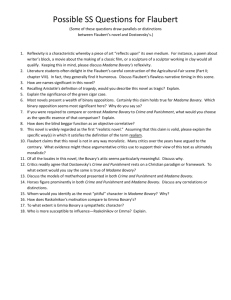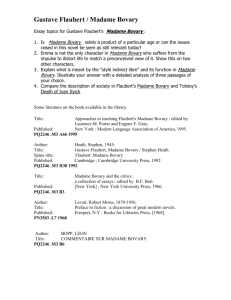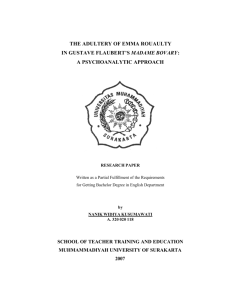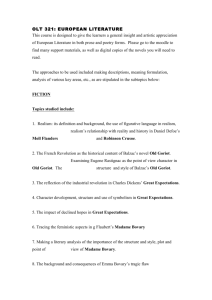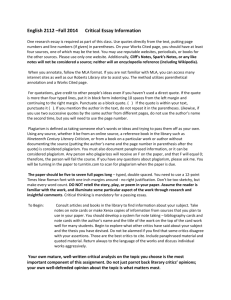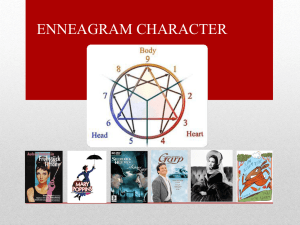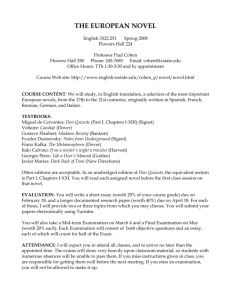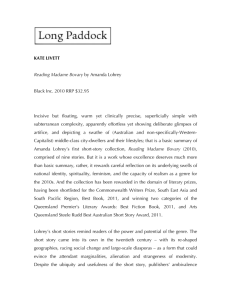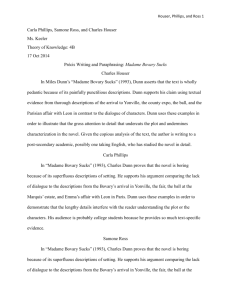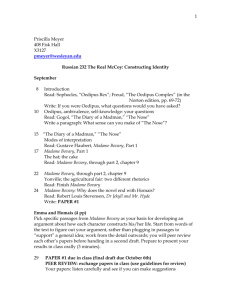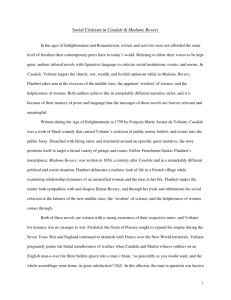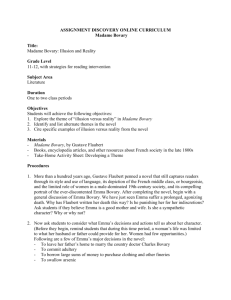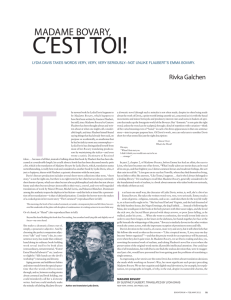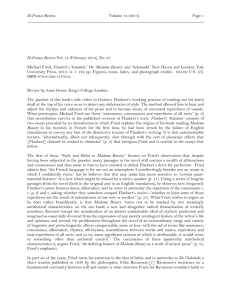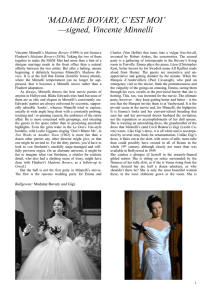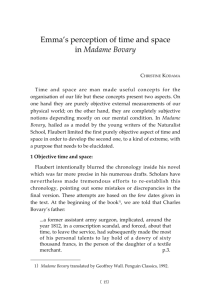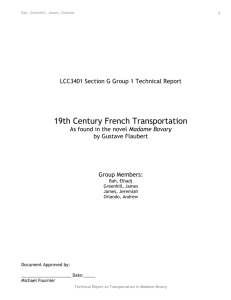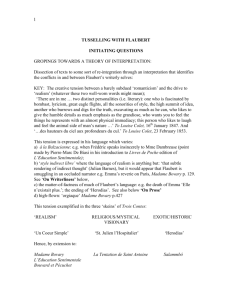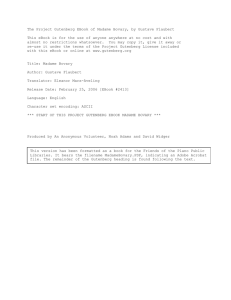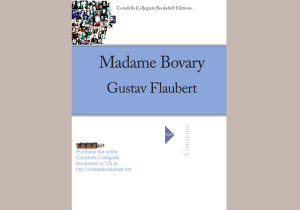Kathrin Becker, Emmas Gift, 2011
advertisement
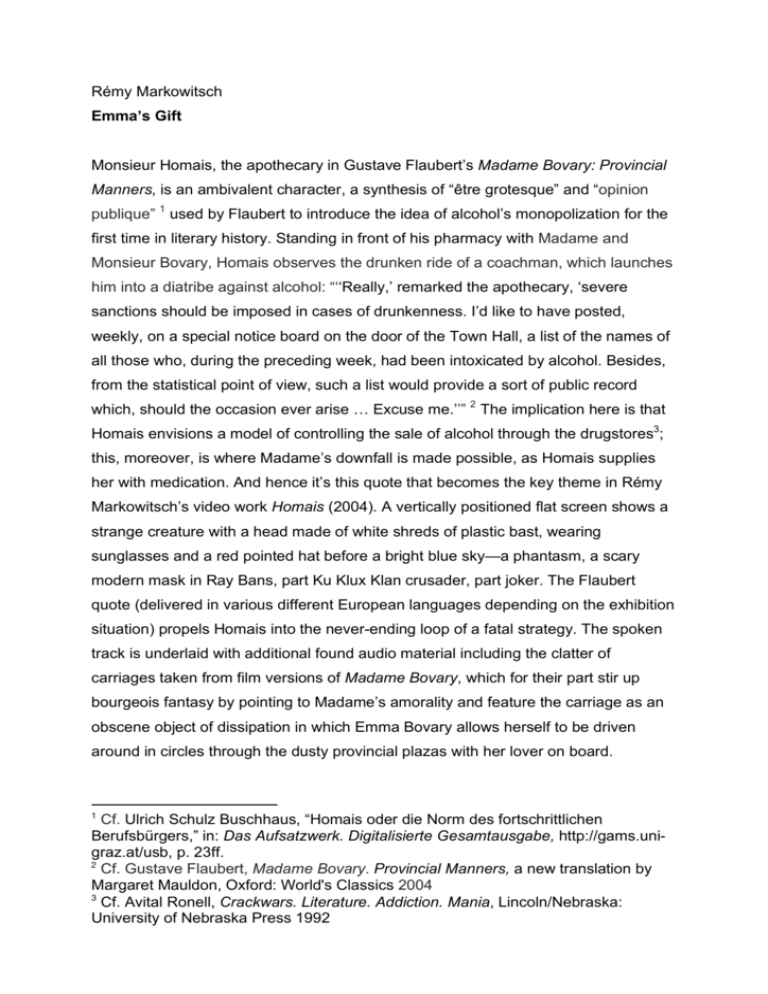
Rémy Markowitsch Emma’s Gift Monsieur Homais, the apothecary in Gustave Flaubert’s Madame Bovary: Provincial Manners, is an ambivalent character, a synthesis of “être grotesque” and “opinion publique” 1 used by Flaubert to introduce the idea of alcohol’s monopolization for the first time in literary history. Standing in front of his pharmacy with Madame and Monsieur Bovary, Homais observes the drunken ride of a coachman, which launches him into a diatribe against alcohol: “‘‘Really,’ remarked the apothecary, ‘severe sanctions should be imposed in cases of drunkenness. I’d like to have posted, weekly, on a special notice board on the door of the Town Hall, a list of the names of all those who, during the preceding week, had been intoxicated by alcohol. Besides, from the statistical point of view, such a list would provide a sort of public record which, should the occasion ever arise … Excuse me.’’” 2 The implication here is that Homais envisions a model of controlling the sale of alcohol through the drugstores3; this, moreover, is where Madame’s downfall is made possible, as Homais supplies her with medication. And hence it’s this quote that becomes the key theme in Rémy Markowitsch’s video work Homais (2004). A vertically positioned flat screen shows a strange creature with a head made of white shreds of plastic bast, wearing sunglasses and a red pointed hat before a bright blue sky—a phantasm, a scary modern mask in Ray Bans, part Ku Klux Klan crusader, part joker. The Flaubert quote (delivered in various different European languages depending on the exhibition situation) propels Homais into the never-ending loop of a fatal strategy. The spoken track is underlaid with additional found audio material including the clatter of carriages taken from film versions of Madame Bovary, which for their part stir up bourgeois fantasy by pointing to Madame’s amorality and feature the carriage as an obscene object of dissipation in which Emma Bovary allows herself to be driven around in circles through the dusty provincial plazas with her lover on board. 1 Cf. Ulrich Schulz Buschhaus, “Homais oder die Norm des fortschrittlichen Berufsbürgers,” in: Das Aufsatzwerk. Digitalisierte Gesamtausgabe, http://gams.unigraz.at/usb, p. 23ff. 2 Cf. Gustave Flaubert, Madame Bovary. Provincial Manners, a new translation by Margaret Mauldon, Oxford: World's Classics 2004 3 Cf. Avital Ronell, Crackwars. Literature. Addiction. Mania, Lincoln/Nebraska: University of Nebraska Press 1992 Inspired by Avital Ronell’s Crackwars, the video work Homais forms a point of departure for Markowitsch’s investigation into the “substances” 4 in Flaubert’s novel: the “bad” literature that Madame is amply supplied with as an antidote to her boredom; the clothes of Monsieur Lheureux, which satisfy Emma Bovary’s desire for the aristocratic and elegant, plunging her into debt and enabling the businessman to appropriate a large part of Bovary’s property; and finally the potions of Monsieur Homais, which alleviate Madame’s suffering in the confines of rural society. Against the backdrop of this cycle of substances, Markowitsch distills a black fluid from the novel that is written in black ink by Flaubert’s own hand and—in keeping with the fame of the author and his work—is then enlarged, sculpted, and covered in a layer of epoxy resin: the object liquides noirs (2011) derives from the handwritten manuscript of the novel’s author and the Édition des manuscrits de Madame Bovary de Flaubert at the University at Rouen (http://bovary.univ-rouen.fr/), which reproduces and transcribes Flaubert’s handwriting, including the author’s editorial changes, thus subjecting the various different edited versions of Madame Bovary to a comparative analysis. The black fluid undergoes a strange metamorphosis and embarks on a journey through Bovary’s organism only to reemerge in the dying Madame once more after the arsenic is ingested: “Then they bent over and put on her wreath. They had to lift her head a little, and when they did so a flood of black liquid came from her mouth as though she were vomiting.” 5 The liquides noirs is both a sign for the merging of the author with his creature (“Madame Bovary—c’est moi.”) and an element that links the two portrait heads in Markowitsch’s sculpture Emma’s Gift (2011). From the mouth of Flaubert’s portrait, the back of whose head is resting on a pedestal, the liquid shoots up as a tapering stream into Emma’s mouth, who is hovering above with her features facing him. While Flaubert’s portrait is depicted realistically, Emma Bovary bears a resemblance to the singer Emanuela Hutter, lead singer of the band Hillbilly Moon Explosion. Markowitsch met Hutter, whom he had made a photographic portrait of years before, at the opening of the exhibition Silence. Selected Works from the Collection (Museum of Art Lucerne, 2009), where Markowitsch’s first work involving Gustave Flaubert, Bibliotherapy meets Bouvard et Pécuchet (2003), was being 4 “Stoffe” (pl.) in German. “Stoff” has various meanings, including “matter” (for a book), “drapery” and “dope”. 5 Cf. Gustave Flaubert, Madame Bovary. ibid, p. 287 reshown. After their conversation revealed a common fascination for the character of Emma Bovary, the idea arose to collaborate on a song for Madame (work in progress) and to give Emma Emanuela’s countenance. Avital Ronell writes: “If the novel goes on after the death of Madame Bovary, drawn out by Homais, it is in order to territorialize another kind of drug story. The same store from which Emma drew the suicidal poison returns to occupy the scene at the end of the novel.” This is because “(t)he drug store figures a legalized reproach to uncontrolled or street drugs that at the same time argues for the necessity of a certain drug culture. (…) There is no culture without a drug culture, even if this is to be sublimated to pharmaceuticals.”6 The ambivalence that resides in the only seemingly controlled administering of psychotropic substances on the part of pharmacies for the purpose of satisfying uncontrolled desires is reflected both in the form and content of Emma’s Gift. The sculpture inverts the power relationship between the sexes, literally placing the woman on top. In addition, the two figures interact through the “fluid” as she bends over him to administer the kiss of the domina and give him the poison that he created himself, which is simultaneously pouring forth from his mouth. The title of the work (which combines the English word “gift” with the German “Gift,” which means poison) also refers to this state of suspension between gifting and poisoning. Thus, Emma’s Gift—like the drugstore itself—“guarantees the preservation of a cadaverous presence while marking the place of its otherness to itself.” 7 Kathrin Becker Translated by Andrea Scrima 6 7 Cf. Avital Ronell, Crackwars. ibid, p. 120ff. Cf. Avital Ronell, Crackwars.ibid, p. 122

